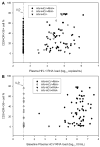CD8(+) T cell activation in women coinfected with human immunodeficiency virus type 1 and hepatitis C virus
- PMID: 18444798
- PMCID: PMC2443164
- DOI: 10.1086/587696
CD8(+) T cell activation in women coinfected with human immunodeficiency virus type 1 and hepatitis C virus
Abstract
Immune activation is a hallmark of human immunodeficiency virus type 1 (HIV-1) infection and impacts innate and adaptive immunity. Individuals coinfected with HIV-1 and hepatitis C virus (HCV) may have increased immune activation early in HIV disease because of a high HCV antigen load in tissues such as the liver. We evaluated T cell markers of activation and maturation in women with or without HIV-1 infection, by HCV antibody and HCV RNA status. We found increased percentages of activated CD8(+) T cells (i.e., CD8(+)HLA-DR(+)38(+) cells and CD8(+)CD28(+)HLA-DR(+) cells) but not of CD4(+) T cells among women who tested positive for HIV-1, HCV antibody, and HCV RNA, compared with HIV-1-positive women who tested negative for HCV antibody. Because CD8(+) T cell activation is related to HIV-1 disease progression, these data may have implications for the medical management of patients coinfected with HIV-1 and HCV.
Conflict of interest statement
Potential conflicts of interest: none reported.
Figures

Similar articles
-
Dominant enrichment of phenotypically activated CD38(+) HLA-DR(+) CD8(+) T cells, rather than CD38(+) HLA-DR(+) CD4(+) T cells, in HIV/HCV coinfected patients on antiretroviral therapy.J Med Virol. 2016 Aug;88(8):1347-56. doi: 10.1002/jmv.24475. Epub 2016 Jan 20. J Med Virol. 2016. PMID: 26765625
-
Evaluating the impact of hepatitis C virus (HCV) on highly active antiretroviral therapy-mediated immune responses in HCV/HIV-coinfected women: role of HCV on expression of primed/memory T cells.J Infect Dis. 2006 May 1;193(9):1202-10. doi: 10.1086/500843. Epub 2006 Mar 17. J Infect Dis. 2006. PMID: 16586355 Free PMC article.
-
HCV coinfection does not alter the frequency of regulatory T cells or CD8+ T cell immune activation in chronically infected HIV+ Chinese subjects.AIDS Res Hum Retroviruses. 2012 Sep;28(9):1044-51. doi: 10.1089/AID.2011.0318. Epub 2012 Mar 2. AIDS Res Hum Retroviruses. 2012. PMID: 22214236
-
Coinfection with HIV-1 and HCV--a one-two punch.Gastroenterology. 2009 Sep;137(3):795-814. doi: 10.1053/j.gastro.2009.06.040. Epub 2009 Jun 21. Gastroenterology. 2009. PMID: 19549523 Free PMC article. Review.
-
Update on hepatitis C virus-specific immunity.Curr Opin HIV AIDS. 2011 Nov;6(6):559-65. doi: 10.1097/COH.0b013e32834b879e. Curr Opin HIV AIDS. 2011. PMID: 22001897 Free PMC article. Review.
Cited by
-
The effect of hepatitis C virologic clearance on cardiovascular disease biomarkers in human immunodeficiency virus/hepatitis C virus coinfection.Open Forum Infect Dis. 2014 Dec 3;1(3):ofu104. doi: 10.1093/ofid/ofu104. eCollection 2014 Dec. Open Forum Infect Dis. 2014. PMID: 25734172 Free PMC article.
-
Persistent immune activation in chronic HIV infection: do any interventions work?AIDS. 2013 May 15;27(8):1199-208. doi: 10.1097/QAD.0b013e32835ecb8b. AIDS. 2013. PMID: 23324661 Free PMC article. No abstract available.
-
Short Communication: Coronary Heart Disease Risk by Framingham Risk Score in Hepatitis C and HIV/Hepatitis C-Coinfected Persons.AIDS Res Hum Retroviruses. 2015 Jul;31(7):718-22. doi: 10.1089/AID.2014.0284. Epub 2015 May 11. AIDS Res Hum Retroviruses. 2015. PMID: 25858663 Free PMC article.
-
Molecular mechanisms of liver fibrosis in HIV/HCV coinfection.Int J Mol Sci. 2014 May 26;15(6):9184-208. doi: 10.3390/ijms15069184. Int J Mol Sci. 2014. PMID: 24865485 Free PMC article. Review.
-
Serious Non-AIDS Events: Therapeutic Targets of Immune Activation and Chronic Inflammation in HIV Infection.Drugs. 2016 Apr;76(5):533-49. doi: 10.1007/s40265-016-0546-7. Drugs. 2016. PMID: 26915027 Free PMC article. Review.
References
-
- Anderson KB, Guest JL, Rimland D. Hepatitis C virus coinfection increases mortality in HIV-infected patients in the highly active antiretroviral therapy era: data from the HIV Atlanta VA Cohort Study. Clin Infect Dis. 2004;39:1507–13. - PubMed
-
- Greub G, Ledergerber B, Battegay M, et al. Clinical progression, survival, and immune recovery during antiretroviral therapy in patients with HIV-1 and hepatitis C virus coinfection: the Swiss HIV Cohort Study. Lancet. 2000;356(9244):1800–5. - PubMed
-
- Rockstroh JK, Mocroft A, Soriano V, et al. Influence of hepatitis C virus infection on HIV-1 disease progression and response to highly active antiretroviral therapy. J Infect Dis. 2005;192:992–1002. - PubMed
-
- Weis N, Lindhardt BO, Kronborg G, et al. Impact of hepatitis C virus coinfection on response to highly active antiretroviral therapy and outcome in HIV-infected individuals: a nationwide cohort study. Clin Infect Dis. 2006;42:1481–7. - PubMed
-
- Sulkowski MS, Moore RD, Mehta SH, Chaisson RE, Thomas DL. Hepatitis C and progression of HIV disease. JAMA. 2002;288:199–206. - PubMed
Publication types
MeSH terms
Substances
Grants and funding
- M01 RR000079/RR/NCRR NIH HHS/United States
- U01-AI-42590/AI/NIAID NIH HHS/United States
- U01 AI031834/AI/NIAID NIH HHS/United States
- R56 AI052065/AI/NIAID NIH HHS/United States
- U01 AI035004/AI/NIAID NIH HHS/United States
- U01-AI-34994/AI/NIAID NIH HHS/United States
- U01-AI-35004/AI/NIAID NIH HHS/United States
- U01-AI-31834/AI/NIAID NIH HHS/United States
- M01-RR-00079/RR/NCRR NIH HHS/United States
- U01 AI034994/AI/NIAID NIH HHS/United States
- U01-AI-34993/AI/NIAID NIH HHS/United States
- M01 RR000083/RR/NCRR NIH HHS/United States
- U01 AI034989/AI/NIAID NIH HHS/United States
- R01 AI052065/AI/NIAID NIH HHS/United States
- M01-RR-00083/RR/NCRR NIH HHS/United States
- U01-CH-32632/CH/OID CDC HHS/United States
- M01 RR000071/RR/NCRR NIH HHS/United States
- M01-RR-00071/RR/NCRR NIH HHS/United States
- U01 AI034993/AI/NIAID NIH HHS/United States
- U01-AI-34989/AI/NIAID NIH HHS/United States
- U01 AI042590/AI/NIAID NIH HHS/United States
LinkOut - more resources
Full Text Sources
Medical
Research Materials

